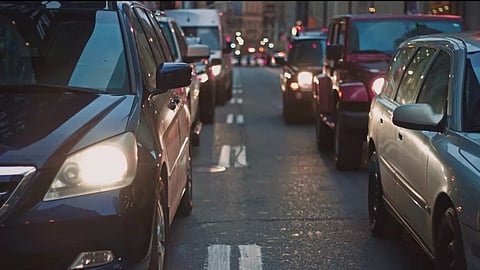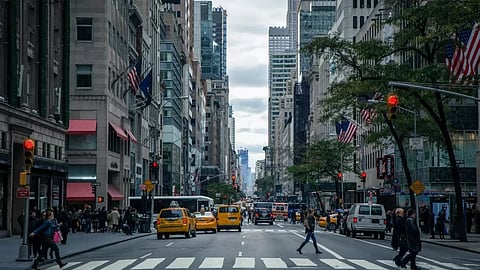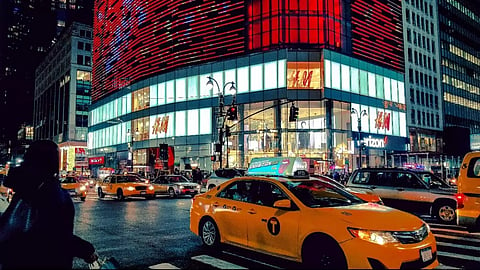The inaugural congestion pricing initiative in the United States is nearing completion in New York City, and it seems probable that the majority of drivers will be required to contribute $15 for access to certain high-traffic Manhattan streets as early as next spring.
$15 Tolls Likely For NYC Drivers To Enter Manhattan’s Busiest Streets Under New Congestion Pricing Program
New York's congestion pricing initiative, close to implementation, proposes tolls up to $15 for Manhattan streets, aiming to generate $1 billion yearly for transit improvements. Despite challenges, it marks a substantial stride in aligning with global traffic management strategies.
On Wednesday, officials offered the most transparent outline yet of the tolls they intend to introduce. Their goal is to generate approximately $1 billion annually, earmarked for enhancing the city's subway and bus networks.
The program encounters several obstacles, such as the necessity for a final vote by transit leaders and a legal challenge from New Jersey officials. Nevertheless, after numerous unsuccessful attempts spanning decades, New York appears ready to align itself with a select group of global hubs implementing a toll program. This initiative seeks to promote public transit usage, curb pollution, and alleviate congestion on some of the world's most traffic-congested streets—specifically, the southern third of Manhattan.
In a concise statement, authorities outlined the proposed tolls for entering Manhattan below 60th Street.

Taxis are expected to include an additional $1.25 per fare, and ride-hailing services like Uber and Lyft would append an extra $2.50 per ride.
The report also disclosed details about the individuals or groups eligible for the most substantial discounts, credits, and exemptions—topics that have sparked intense debate. These recommendations were selected from a range of possibilities extensively examined over the past year.
“It’s a huge step forward for the region,” said Carl Weisbrod, the chairman of the Traffic Mobility Review Board(TMRB), an advisory panel that wrote the report. “We’ve seen it work elsewhere around the world, and now it is becoming concrete.”
London, Stockholm, and Singapore boast congestion programs recognized as models for effectively managing traffic. New York’s proposal would cost a typical motorist a bit less than London’s and a bit more than Stockholm’s.
The Metropolitan Transportation Authority's board, tasked with overseeing the program, retains the authority to make adjustments to the pricing structure. Following the release of the advisory group's report on Thursday, public input will be sought. Meanwhile, opponents of congestion pricing continue their efforts to derail it in court.
The plan had faced prolonged delays over several decades due to a multitude of concerns raised by commuters, civic leaders, and business figures. Many drivers were apprehensive about additional tolls on top of existing ones, while other critics expressed concerns about potential traffic and pollution diversion to other areas of the city.
Urban planning experts emphasized that, despite the program aiming to achieve its intended objectives, the authority must vigilantly observe the tolls' impacts and implement adjustments if any adverse effects arise. Yonah Freemark, a researcher at the Urban Institute, pointed out the inherent uncertainty in predicting how the fees will ultimately reshape traffic patterns.
“We’ve seen some previous evidence that the congestion charge, according to some models, may result in more traffic and more pollution in parts of the Bronx because of people choosing not to go through the central business district,” Mr. Freemark said. “I think that’s something that deserves monitoring.”
Several groups have pushed for exemptions, such as taxi and Uber drivers, as well as suburban residents, leading to delays in the program's approval. The most aggressive objection has been mounted by New Jersey lawmakers, who filed a lawsuit against the federal government in July for endorsing the plan. Officials in the state expressed worries that the tolls could impose unjust financial and environmental hardships on residents. The outcome of the lawsuit is still pending.
Currently, there are no impediments preventing the M.T.A. from progressing with the program and revealing a pricing structure that likely represents its near-final version.

The tolling structure put forth by the advisory group features minimal exemptions, discounts, and credits, a decision made to prioritize benefiting "the many, not the few," according to Mr. Weisbrod.
The proposal aimed to find a middle ground among numerous conflicting interests. Supporters lauded the proposed rates as fair and comparable to those in other cities worldwide.
Lisa Daglian, who serves as the executive director of the transit authority's Permanent Citizens Advisory Committee, a watchdog group, emphasized that congestion pricing would provide much-needed funding for signals, new train cars, and electric buses. “Congestion pricing is not only an idea whose time has come,” she said. “It’s long overdue.”
In a prepared statement, a spokesperson for Governor Kathy Hochul highlighted her criticism of a $23 fee. The statement underscored the governor's endorsement of congestion pricing, emphasizing the imperative to enhance New York's transit system while simultaneously addressing pollution and traffic issues.
NYC CONGESTION PRICING DISCOUNTS AND EXEMPTIONS
Drivers with low income will receive a 50 percent discount on tolls during the day after their first 10 trips in a calendar month. Additionally, driving at night will be significantly more affordable, with fees reduced by 75 percent between 9 p.m. and 5 a.m.
Passenger vehicle drivers entering the congestion pricing zone via the Queens-Midtown, Hugh L. Carey, Holland, and Lincoln Tunnels will be granted a $5 credit during daytime hours. Motorcyclists will benefit from a $2.50 discount, while small commercial trucks will receive a $12 credit, and larger trucks will enjoy a $20 discount. Notably, drivers crossing into Manhattan over the George Washington Bridge, situated north of the congestion zone, will not receive a discounted toll.
Certain vehicles transporting individuals with disabilities and authorized emergency vehicles will be exempt from charges. Residents with a primary residence inside the tolling district, earning below $60,000, would qualify for a state tax credit equivalent to the total amount of their tolls.
The congestion pricing zone extends from 60th Street to the Battery but excludes the Franklin D. Roosevelt Drive on the East Side of Manhattan and the West Side Highway.
The authors of the report faced challenges in determining the appropriate charges for commercial trucks due to concerns about potential air pollution in some of New York City's impoverished neighborhoods resulting from diverted traffic. However, the M.T.A. has now officially pledged millions of dollars in investments for these communities. This includes $20 million for an asthma-fighting program and $10 million for the installation of air filtration units in schools located near highways.
According to Mr. Weisbrod, the aspiration is that commercial drivers will choose to operate during nighttime hours to alleviate daytime traffic and avert the formation of new congestion points.

The committee also wrestled with determining the appropriate charges for taxis, considering the concerns of cab drivers who worried that increased fares might lead to a decline in taxi demand. The latest report proposes charging yellow cabs less than for-hire vehicles to address worries that additional costs could disadvantage them against Uber and Lyft. However, it falls short of granting cabbies the complete exemption they had sought.
The rates put forward this week will undergo public hearings before a definitive vote, potentially occurring as early as early next year. In the meantime, the M.T.A. has reported that it has already implemented 60 percent of the electronic equipment needed to toll drivers.